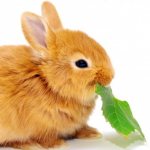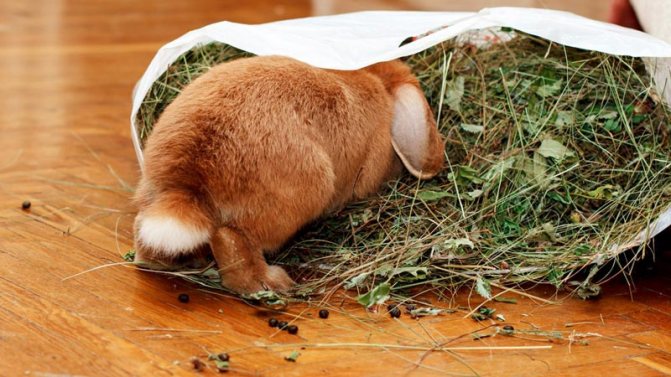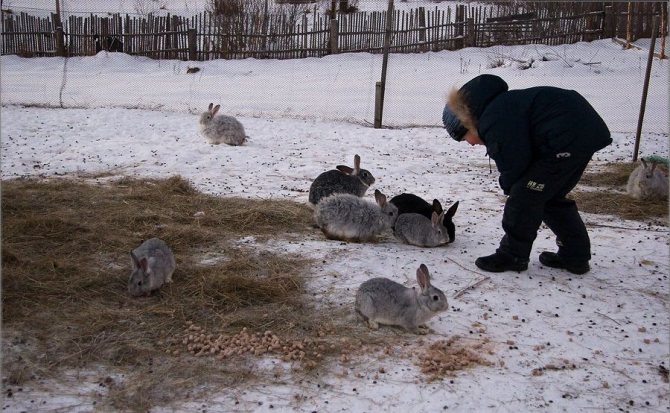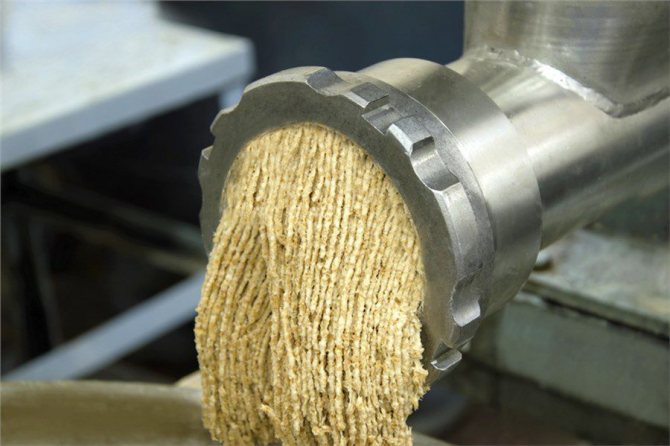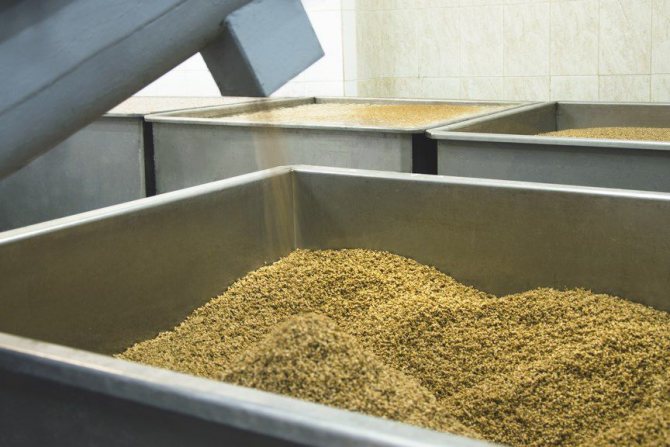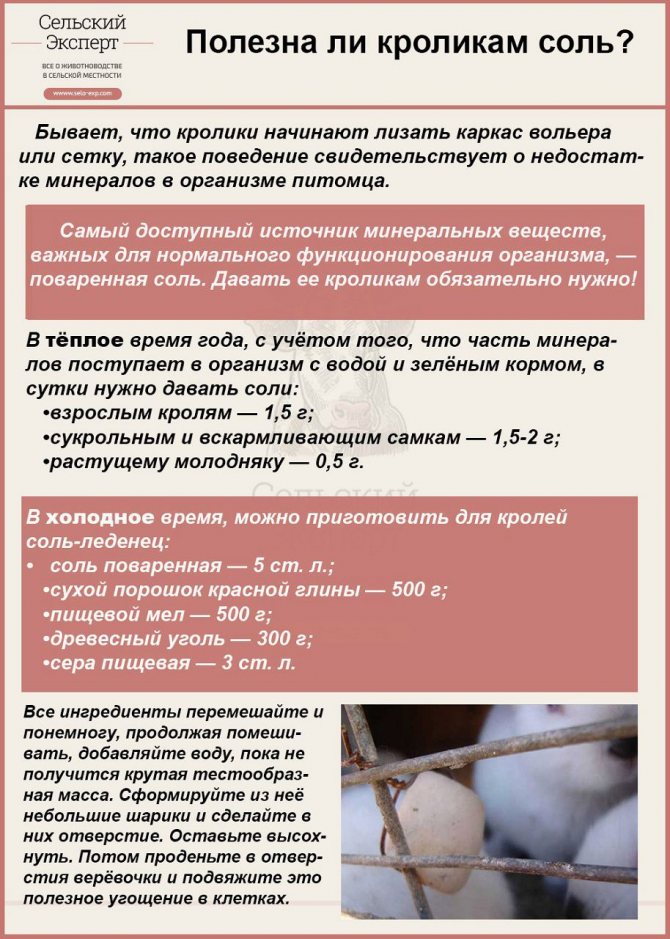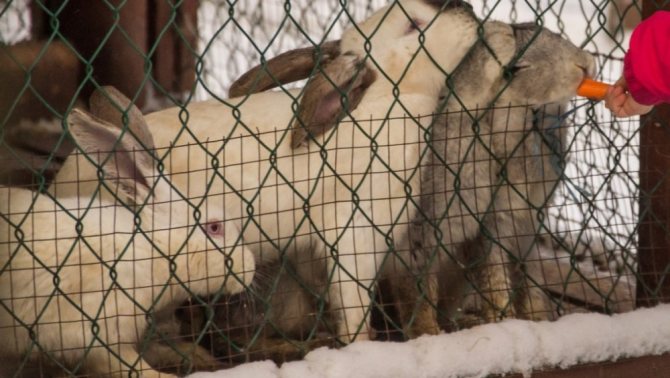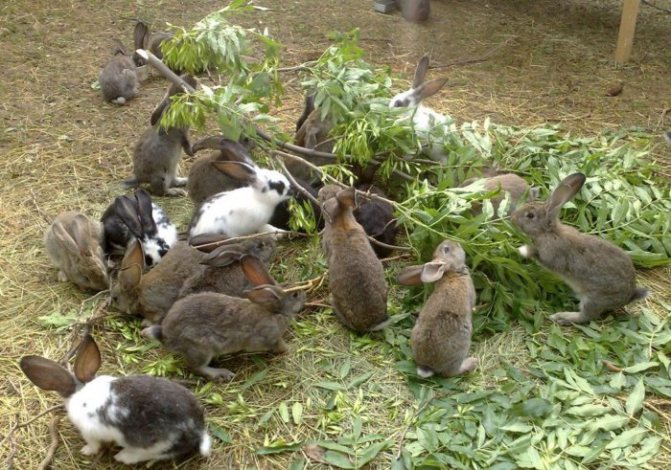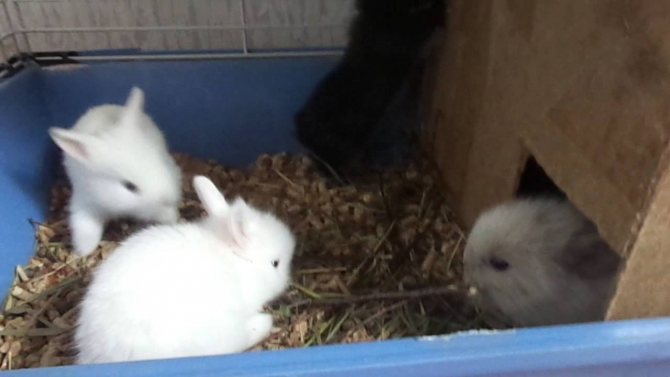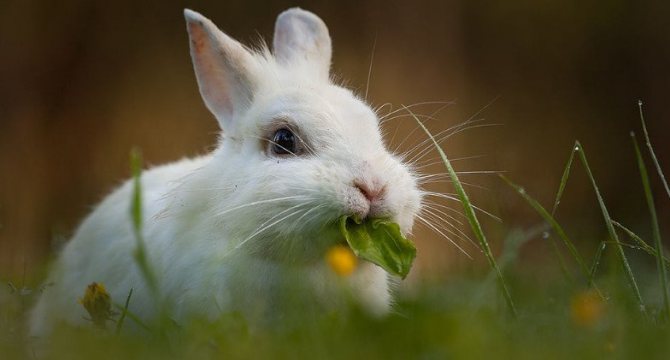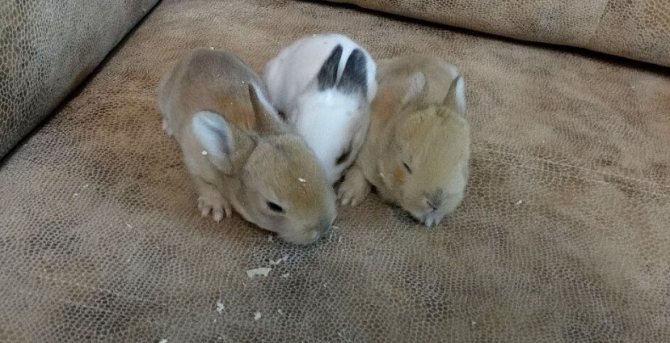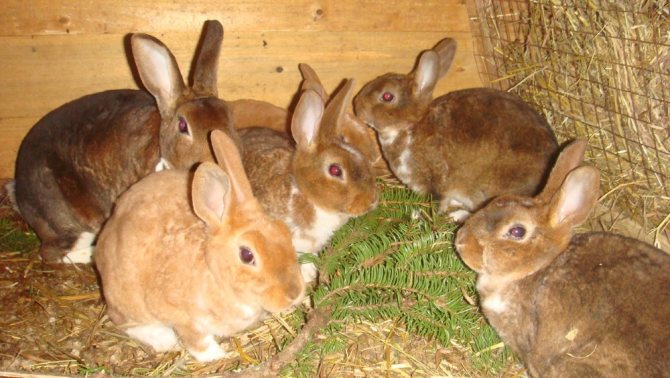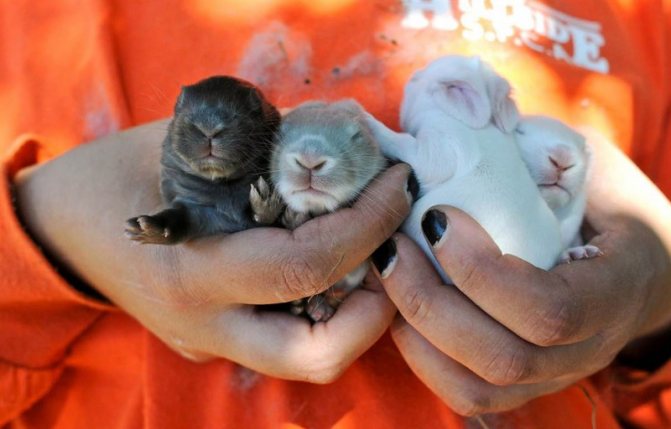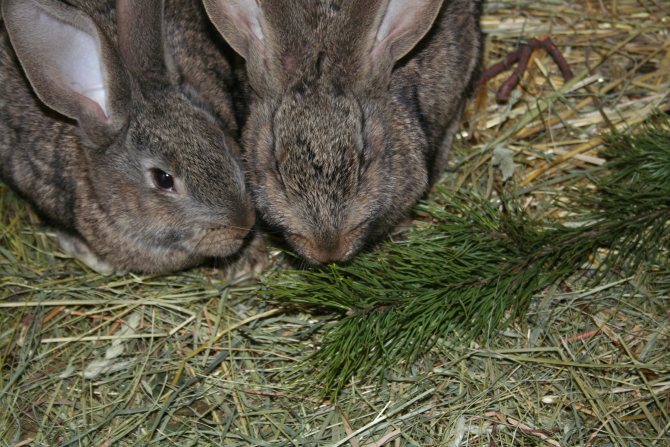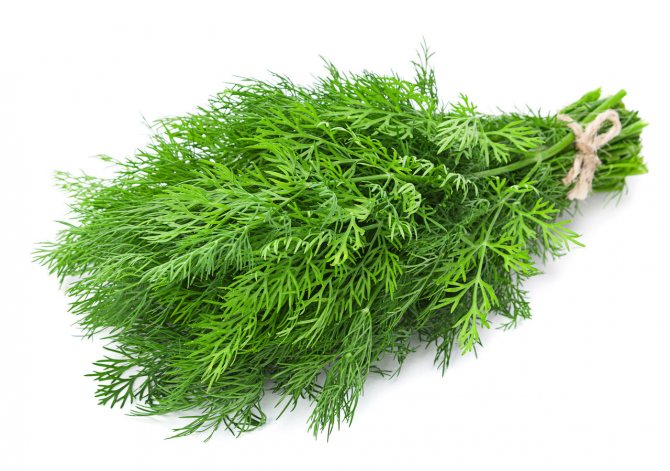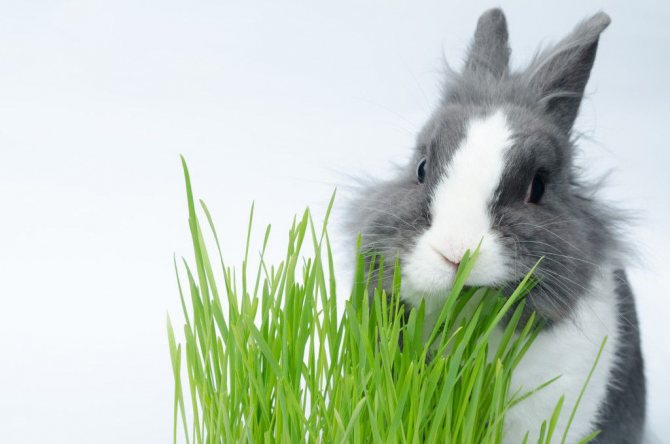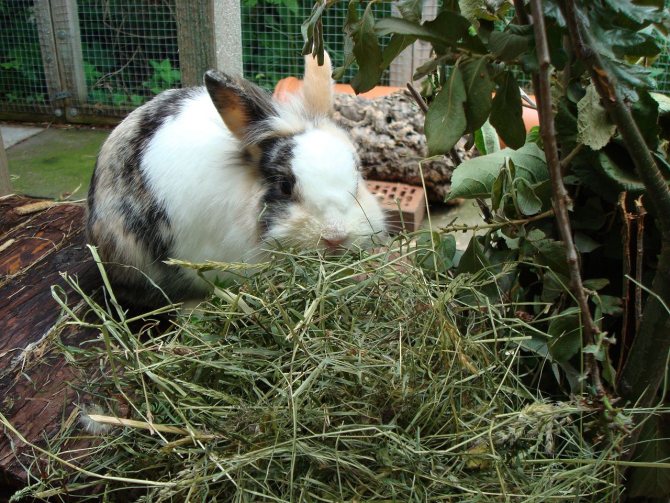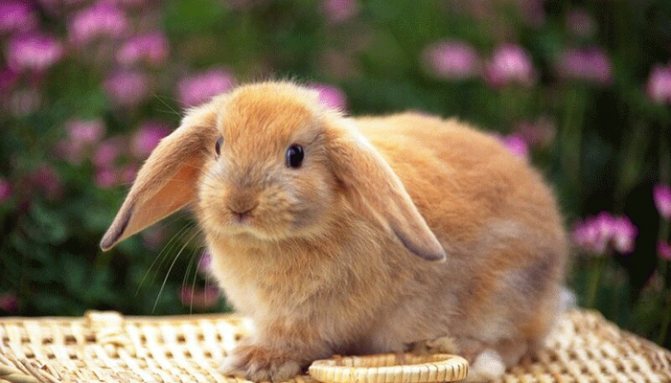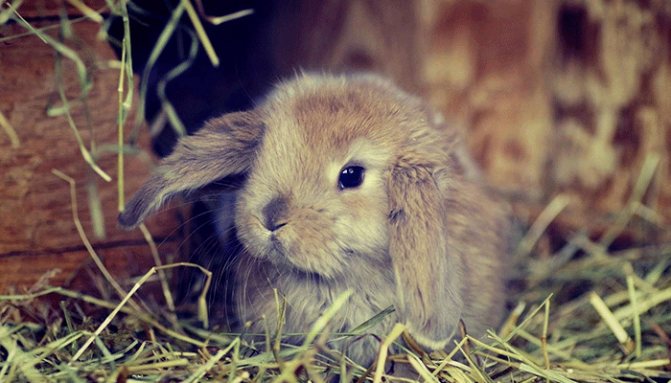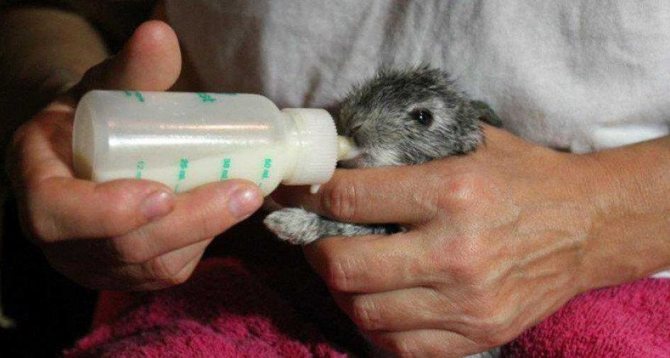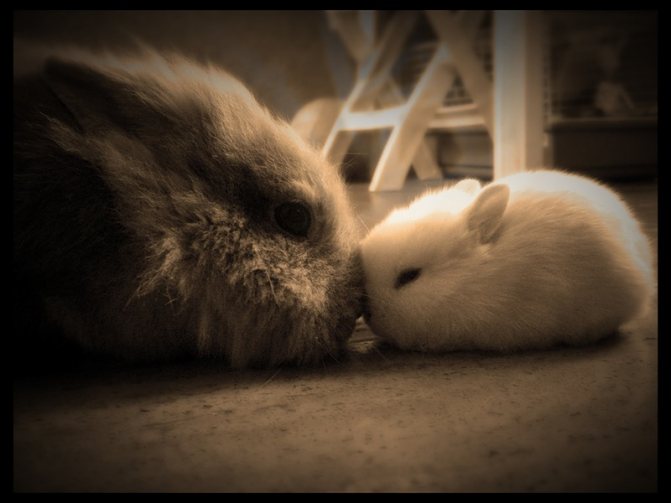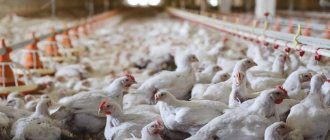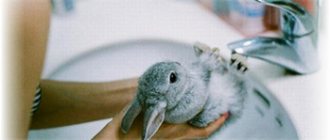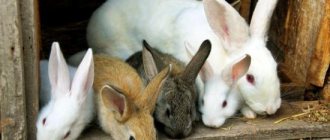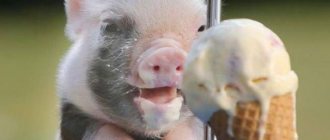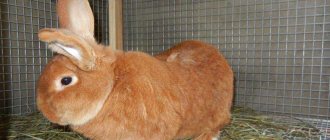Rapid weight gain of rabbits is a guarantee of high efficiency of the farm. That is why, at the planning stage, it is worth carefully choosing a breed and calculating the diet of animals. The best rabbits to grow are characterized by rapid weight gain in a period of 1 to 3 months, after which they produce a large amount of tasty and tender meat. However, not everything is determined by genetics: the second most important factor is the choice of the optimal diet.
Rabbit feeding
Why do rabbits slowly gain weight, grow poorly?
There are many questions of this kind on the Internet. Why are my rabbits not gaining weight well or not growing at all and dying? Imagine that one person at the age of 18 grows up to 2 meters, has a weight of 90-100 kg, and another in the same years, only 150 cm and weighs 40 - 45 kg. At the same time, the diet is practically the same. Genetics, you say, and you will be right, but only partially. Doesn't it affect the growth rate of living conditions, diet, sports, child's health, parents' health and many other things. Approximately also in our eared pets.
List of reasons why rabbits do not grow fattening
Scientists have identified the main reasons why rabbits grow poorly. There are three main reasons why rabbits are stunted and do not gain sufficient weight at different stages of beef feeding:
- Genetic (innate) potential of the breed.
- Organization of conditions for keeping and feeding rabbits.
- Experience and knowledge of the owner of the principles of organizing breeding selection of animals.
Diseases, their consequences on the genetic potential, other reasons are attributed to force majeure (emergency) factors that must be avoided.
The value of the breed of rabbits on the rate of weight gain
In an experienced breeder, even outbred rabbits gain weight faster than your purebred ones. But we said that gaining weight quickly in rabbits is a complex problem. The best rabbit breeds for Russia (Soviet chinchilla, NZB, Californian, Vienna blue, Black-brown, White and Gray giants, Silver). These breeds gain weight potentially faster than others. Good indicators of weight gain are given by breeds (White Pannon, Burgundy, Butterfly). Novice rabbit breeders are looking for information about hybrid rabbits of the first generation and crosses (hybrids) of the second or third generations.
Tips for choosing a rabbit breed that is gaining weight quickly
- Do not select breeds from the list of our site if there is another breed in your area that is supported by experienced breeders. Practical advice from an experienced person is always more valuable than correspondence advice. Moreover, the best breeds differ from region to region. In a short time, you will achieve more than studying the information on the fila rabbit website.
- Do not chase trendy, foreign breeds (Burgundy rabbit, White Pannon, Lop-eared giants, and also crosses, which are called hybrids). Do not take rare breeds if there is no serious rabbit research center nearby, such as FGBNU VNIIPZK im. V.A. Afanasyev ". Otherwise, behind the high cost of exotic rabbits lies the helplessness of breeding support. You will be sold a pedigree marriage and forgotten, in short….
- Don't look for accelerated rabbits. There is no such breed.The term is coined for rabbits that are raised outdoors and fed with organic food. Accelerates are rabbits of various breeds raised in the village. Is not it so? The advice does not apply to the followers of People's Academicians Igor Nikolaevich Mikhailov, Trofim Denisovich Lysenko and hardening guru Porfiry Ivanov (baby).
Under what conditions (cages or pits) rabbits gain weight better
In theory, a young man who grew up in a village doing manual labor is healthier than a city peer. It turns out that rabbits are also better to grow in burrows and pits close to natural conditions? The ecological environment of the content is indeed more attractive in the short term. Meanwhile, if your rabbit breeding in the pit for 2-3 years does not end in collapse due to mass mortality, it will inevitably lead to the degeneration of the herd.
Rabbits in the wild live for themselves, not for your ambition to grow them faster
You can't do without serious appraisal, in terms of weight gain. It is practically impossible to organize breeding work with the pit and burrow keeping of rabbits. It is only in cells that it is convenient to carry out directed selection. Agree, the offspring, which at the age of 30-40 days, has the greatest body weight, and then grows faster on fattening. At the same time, the feeding rates of rabbits before slaughter at 120-150 days are the same for the entire group.
Summarizing
Fattening of farm rabbits has been gaining popularity all over the world lately. The meat of these pussies is valued primarily for its nutritional value and dietary quality; it is recommended for people with congenital heart and kidney defects.
In the wild, rabbits eat plant foods, but there are various ways to feed these animals to improve the palatability of the meat on farms. Most often, the broiler feeding method is used, but for small farms, the usual one is sufficient.
Influence of the milk period on the growth rate of a rabbit
A novice rabbit breeder asks a video question, asks experienced breeders, via youtub hosting. My rabbit gave birth to 15 young rabbits, but gradually they all died, help, name the reason why the rabbits do not gain weight and die. Let me answer. The rabbit has 8, rarely 10 working teats. If half of the rabbits do not receive enough nutrition in the early period, then either the rabbits should be placed with other females, or the mother should be fed intensively. It is known that a good, dairy rabbit is able to feed rabbits more than she has nipples, but with increased feeding. The average weight of rabbits at birth is about 50-60 grams.
The milk period in a rabbit lasts from birth to 21 days, then complementary foods begin in the form of grain, hay
In the milk period, the rabbits double their weight in 6 days. By the weaning period of 30-40 days, the weight increases 10 times. Colostrum and then milk is the health of young rabbits in the early stages of life.
The better to feed the rabbits during the suckling period, the more chances to gain the required condition by the end of the fattening period.
Everything that prevents them from gaining weight "sticks" to weak hypotrophic rabbits. Sometimes hungry rabbits bite and injure the nipples of the female, causing mastitis - inflammation of the mammary glands in a nursing mother. Hungry rabbits are easy to distinguish without disturbing the female and the babies. They often squeak, spread out, and look wrinkled. Start to act, otherwise it will be too late, you will not achieve good weight gain in fattening.
Methods for breeding rabbits for meat
The way of feeding rabbits plays no less role than a properly balanced diet of eared ones. Meat acquires the best taste at 6-7 months of the rabbit's life.
But there are different ways to achieve this. Improving taste is also corrected by special foods in the rabbit's diet.
Broiler method of breeding rabbits
This is a common method used on large farms. For broiler breeding, meat rabbits are not separated from the mother until slaughter.Due to the nutritional value of milk, rabbits quickly gain weight, and the rabbit, in the meantime, is sent back to mate.
The main advantage of this method is saving on cells.
At the same time, such intensive feeding greatly depletes the rabbits, therefore it is recommended to give them an increased amount of compound feed, otherwise the females' immunity is weakened, milk disappears and the reproductive system is disturbed. Also, from frequent feeding and non-observance of sanitary standards for keeping rabbits, diseases of the mammary glands develop.
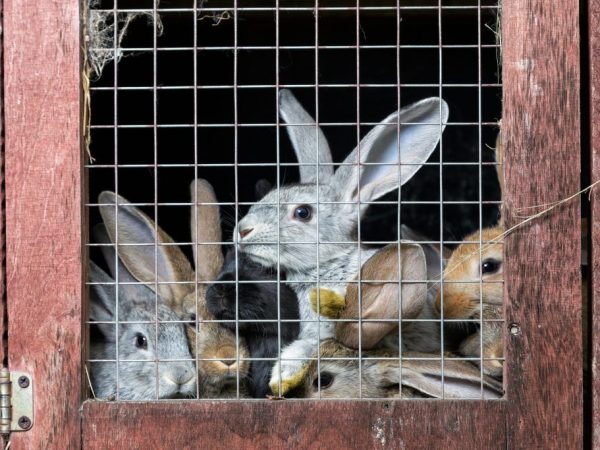
Broiler breeding of meat rabbits
The skin of broiler rabbits has a low value, but the meat is nutritious and has a high taste. For this breeding method, meat breeds such as the White Giant, the Silver Crab and the Soviet Chinchilla are used. These types of rabbits are particularly early maturing and quickly gain weight due to the female's milk. Usually, the weight at the end of 6 weeks of these rabbits already reaches 2-3 kg.
Concentrated feed in the diet of a rabbit during lactation should be at least 50% in summer and up to 60% in winter. Rabbits will grow faster if they receive about 150 g of protein per feed unit. Hay is used from dried legumes, they also contain vitamins, but the nutritional value is much higher. Broiler pets can be given any amount of water.
Common method for feeding young rabbits
When using conventional fattening, young rabbits for slaughter should be removed from the female in the second month. The diet should also consist primarily of concentrated feed. The first 10 days after jigging, the eared should receive 450 g of legumes and 45 g of pure grain.
In parallel with this, the animal can be fed with a balanced compound feed. Within 2 months, these values increase by 1.5 times, and by 3 months - 2. By the age of six months, the rabbit is already allowed to be slaughtered. Usually fattened meat does not have the same high taste as broiler meat, but wool is an order of magnitude better and can bring some profit.
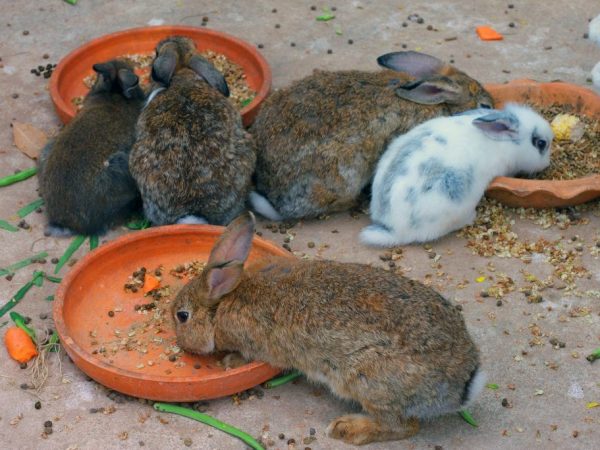

Feeding young rabbits
On large farms over 200 heads, both methods are used in parallel. This allows the females to be relieved of the burden and to obtain equally high quality meat and good skins for sale. Medium-sized farms of up to 200 animals per herd alternate these feeding methods for young rabbits to give the females time to recover. With a herd of less than 100 rabbits, the usual method of feeding is used, and broiler feeding is not more than 2 times a year.
Rabbit diseases that interfere with weight gain
In principle, all diseases during feeding interfere with weight gain. However, most diseases are rare in young animals. The main infectious disease that affects the rate of weight gain in rabbits is coccidiosis (eimeriosis). The causative agents of coccidiosis are specific for each animal species. Coccidiosis of rabbits and chickens has different pathogens.
Coccidia are natural inhabitants of the organism of rabbits from the first days of life.
Even an absolutely healthy rabbit has unicellular organisms (coccidia) in a state of mutually beneficial (symbiotic) relationships. Normal coccidia (eimeria) are involved in digestion, the breakdown of plant fiber. They quickly turn into dangerous parasites, with the slightest decrease in the body's resistance. The rabbit doesn't even need to get infected. A former "helper", he quickly becomes his worst enemy. As a result, a “vicious circle” of pathogenesis develops. It looks like this:
Decrease in the body's defenses → the initial stage of coccidiosis → further weakening of the body due to illness → complicated stage of coccidiosis → and so on
During the period of an infectious disease, no amount of food will help rabbits gain weight quickly.
Feeding and drinking regime, influence on weight gain of rabbits
The feeding rhythm of rabbits is important for gaining weight quickly. Lagomorphs (a detachment of rabbits) must constantly chew, otherwise digestion "stops", weight gain decreases.
The daily ration of feed for a rabbit from which a quick weight gain is expected at home is as follows:
- Grain feed. Compound feeds, grain mixtures, grain mash should be given once or twice a day. If you give grain feed in dry form, it is better to fill it in hopper troughs.
- Hay, branch feed. Give ad libitum, this type of feed should never end up in a manger feeder.
- Juicy feed. Feed with a high moisture content complements drinking. They have a rich vitamin and mineral composition. Juicy forages have no nutritional value for fattening, except for potatoes, fodder beets and some others in steamed mash.
- Water. Drinks are available in nipple drinkers, or poured into drinking cups at specific times. During breeding periods, the need of rabbits for water increases, at a certain point it even reaches a double norm.
- Mineral supplements. Bone meal, salt are required only in homemade feed. Others, if necessary, should be added to old and low-quality grain feeds. Useful substances are available in fresh, complete feed.
After being deposited from the mother
After jigging rabbits from their mother (and it happens at different times, but not earlier than 20-24 days), you need to carefully monitor their digestion. Having ceased to receive from the mother some of the enzymes with milk, grown-up babies learn to digest rougher food. Already from 20 days, the rabbits fed by their mothers try a little adult food. Therefore, after jigging, the process of adaptation to coarser, juicy or green food goes naturally.
During this period, animals are boldly given vegetables, cereals. Also, good soft hay is introduced, a small amount of grass granules (about 3% of the rabbit's weight per day). You can give the young growth cooled grain boiled with boiling water, greens of wild plants, a little bran. When more than 20 days have passed from the moment of jigging, the rabbits can be completely transferred to an adult diet. Dry food is given in the morning, more moist food in the middle of the day.
Influence of feed quality on the growth rate of rabbits
Even a novice rabbit breeder notices that rabbits willingly eat one type of food, and practically leave the other in the trough. The choice of food must be approached especially carefully. Musty, moldy, rancid food should not be given to rabbits, due to the danger of subclinical mycotoxicosis
Instead of ready-made, high-quality granulated feed, you can use different types of ordinary grain and prepare the feed yourself. It is better to give grain to rabbits:
- in the form of a large turtle (crushed) feed;
- or in the form of homemade mash of different types of whole grains and juicy steamed feed.
Methodology for calculating the composition of the diet for rabbits
It is unlikely that a novice rabbit breeder at home will independently and seriously calculate the rabbit's diet in terms of dry matter (protein, fiber, fat), feed units, the need for minerals, amino acids, vitamins. If you wish, contact the feeding department of any nearby agricultural educational institution. They will help you to calculate professionally and even for little money. It is pointless for a beginner to read the Internet on the difference between acid-degenerative fiber and acid-degenerative lignin. Moreover, in order to understand the importance of essential amino acids for rabbits and where to get them without feed additives, you need to study at least three courses at the zootechnical faculty. Such knowledge is needed exclusively for the organization of industrial feeding of rabbits. Experts who know how to professionally compose the diet of large groups of animals will be found among animal engineers - rabbit breeders.
Increasing the mass of rabbits in additional ways
Rabbit breeders with extensive experience use auxiliary methods to activate the increase in pet weight.
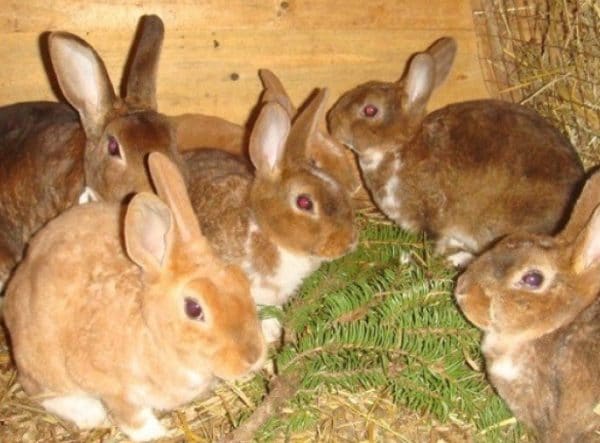

The basis of the winter diet of rabbits is roughage and concentrated feed.
Additional productive methods that provide weight gain in animals include:
- Rational seating of rabbits. In a herd, animals are divided into stronger and weaker ones. All pets are required to receive food in equal portions. To do this, you need to group rabbits according to their temperament.
- Limited space. The mobility of the rabbits is limited by the small area. With minimal movement, rabbits can gain weight quickly.
- Control over the filling of the feeder. After each feeding (4-5 times a day), the food container is cleaned out. Empty food boxes are refilled.
Breeders successfully use another feature of rodents - activity at night. Shielding the cage from daylight increases the rabbits' need for food. But regular overexposure of animals in semi-darkness is contraindicated.
Rabbit diet table
At home, you can do it simply. For domestic, non-professional rabbit breeders, it is clearer how to organize feeding rabbits for weight gain using simple examples. Rabbits are very profitable animals for growing meat mass. The most expensive feed is very little grain, only 30-35% of the diet. Although there is other information, 50-60%.
The main grain feeds are oats, barley, corn, and wheat. Some rabbit breeders feed rabbits with grains of sorghum, rye, peas, lentils, soybeans.
We are the basis of how you can feed rabbits at home, we recommend a basic diet that every rabbit breeder can modify at home, include other feeds that are optimal for gaining mass:
- Grain mixture. Consists of ¼ parts of each feed (oats, wheat, barley, corn). Mix all types of grain, crush into large pieces on the day of feeding. Sometimes wheat bran is used instead of wheat. The grain mixture can be given dry or steamed. The daily amount of grain is from 25 to 50 grams per one fattening rabbit. from 30 to 110 days. Every 10 days, increase the amount by 10 grams.
- Sunflower cake (product remaining after sunflower pressing) or meal (sunflower extraction product). Both products are by-products in the production of sunflower oil. Nutritional value is preferable to cake. It is richer in protein and fat. Both products must be calcined before giving to rabbits. This measure is necessary to destroy harmful substances, microbes. Fried sunflower cake first give from 30 grams, and then reduce to 10 grams.
- Potatoes. It can be given alone or mixed with grain in the form of a mash. Potatoes contain a lot of starch, in the form of a steamed, crushed feeder. Potatoes are given from 70 grams per day. Increase to 130 - 200 grams closer to the end of fattening.
- Grass hay or freshly cut (dried) grass is given free, the approximate rate for fattening is 100-200 grams per animal. For the entire feeding period 10-15 kg.
- Feed additives, in the form of table salt, are given in a dose of 0.3 to 1.5 grams per animal. Meat and bone, bone or fish meal is added from 1.0 to 5.0 grams per rabbit.
Rabbit Supplements
The lack of vitamins will instantly affect the health of animals, causing pathological changes. Novice breeders often face a problem when rabbits do not grow and do not know what to do.
Cessation of growth, lethargy, a tortured appearance, decreased appetite are a clear sign of a lack of vitamin B.
Important! Lack of vitamin B1 in the body negatively affects the digestive tract of animals. Diarrhea often occurs, animals are nervous, the heart system begins to work intermittently, convulsions, paralysis of the limbs may occur.
With vitamin D deficiency, female females can shed their offspring, and the surviving babies will be sick with rickets. The rabbits interrupt the feeding of the cubs, since lactation stops, the paws of the adults are twisted.
To eliminate and prevent vitamin deficiency, animals are given chiktonik, and feeding is increased. As a dietary supplement, rabbits are fed foods rich in vitamins:
- A - fresh fruits and vegetables, green food;
- B1 - sprouted wheat. Fresh potatoes, yeast;
- B2 - silage, bran, dairy products;
- B12 - algae, seaweed, bone meal and fish meal;
- D - Fish oil.
On a note! Getting the necessary vitamins with food additives, animals actively reproduce, grow, eat well, their fur begins to shine.
Recommendations rabbit breeder Zolotukhin
Many years of practical experience are outlined in the recommendations for feeding rabbits at different stages of housing.
- Immediately after accustoming to self-feeding (2-3 weeks). Feed steamed oats.
- Closer to one month of age (weaning) and beyond. Gradually introduce barley dough into the diet. Closer to the warm season, replace steaming with dry feeding.
- Finishing of fattening at 5-6 months. Closer to 3-4 months. Add corn to the diet. Dry feeding.
- Rabbit dry. Feed whole oats.
- Fertile and pregnant females, in the dairy period, give a mixture of oats, barley, corn.
How to feed properly?
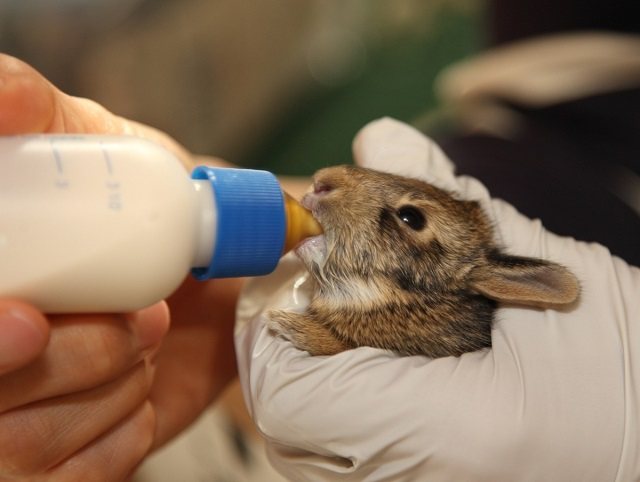

Rabbits are born blind, without hair on the body, weighing about 60 g.
The first fluff breaks through on the 5th day, and the eyes open no earlier than 10th day.
Without the ability to see and move freely, eating skills are absent. Babies are completely defenseless, so the loss of a nursing mother is very dangerous for them.
A person must fulfill the functions of a rabbit. You will need to master certain skills, acquire inventory.
In the first days of life, babies need a nipple. Its role can be played by:
- large pipette;
- syringe without a needle, 20 ml;
- a clean vial of eye drops;
- small baby bottle;
- special kit for feeding animals.
The craftsmen are improving the syringe and the bottle from drops for the convenience of feeding. A rubber pipette cap is placed on the spout of the selected container. Several punctures are made in the rubber beforehand.
In store kits, there is a special syringe and tips of different sizes.
As the rabbits grow, the attachments can be changed, going from pipette to bottle. From day 20, most babies begin to feed on their own from a saucer.
Feeding should be built as close to natural flow as possible. The more accurately the details are copied, the faster the animals will acquire instincts.
Until the eyes open, newborns show mild reactions to the artificial nipple. Milk has to be poured into the mouth. In this case, it is important to squeeze out the liquid gradually so that the baby does not choke.
For the first 2-3 days, it is better to start feeding with smearing milk around the mouth. The bunny will lick it himself. For inactive individuals, the procedure is repeated several times.
If the bunny revives when he feels the taste of food, you can proceed to pouring in a few drops.
A blind baby can eat no more than 1 ml of milk at a time. The abdomen should not overflow. Overfeeding threatens gastric disorders, inflammation of the respiratory system.
The bunny must be held vertically in the hand, without squeezing the body.
The liquid is stored in the refrigerator for no more than 72 hours, heated up to 37-38 ° C before the procedure. The mixture is always prepared fresh.
The easiest way to determine the optimal feeding hours is by observing the behavior of the young.
Well-fed cubs behave calmly, quietly, sleep a lot. In a hungry state, they become restless, try to move in search of their mother and squeak.
Feeding according to age


At each age, the rabbits require their own feeding schedule. The frequency is adjusted to the rate of food digestion. Appetite increases with the growing body.
By the end of the first week, babies are already able to overeat, so it is necessary to comply with the norms for their health. Until 30 days, the diet consists only of milk.
Birth to Day 5 (Daytime)
A newly born rabbit is given literally 1 drop of liquid. During the day, the number of drops is gradually increased in 5-6 visits. The animal does not yet have a good swallowing reflex, so special care is needed.
From the second day, it is enough to feed 4-5 times. By the end of the period, the baby should double its birth weight (120-180 g for different breeds). On the fifth day, food is given 4 times.
6-14 days (weekly-fortnightly)
From the 6th day, the young rabbits are fed three times a day. This regime lasts up to 2 weeks. During this time, the weight of babies reaches 200-260 g. Portions gradually grow with the animals.
From 15 to 30 days
15 and 16 days, individuals are transferred to a two-time diet.
Observe their behavior, if there is not enough food, add a little mixture in the form of a third feeding.
From the 17th day onwards, the portions become impressive, the body prepares for the adult regimen, therefore, two feedings are not exceeded. By the 30th day, the rabbits weigh about 500 g.
Depending on the breed, the weight may be slightly less or more. Weaning from the nipple begins by the end of the third week. Early ripening species are often ready for the introduction of other products as early as 20-25 days.
Readiness can be tracked by the behavior and condition of the teeth. When milk teeth are almost completely replaced by molars, interest in solid food wakes up, the animal is transferred to a new food.
As you grow, the amount of milk increases. The larger the breed, the larger the single serving:
| 1-7 days | 5 ml (1ml) |
| 8-14 days | 20 ml (5ml) |
| 15-20 days | 20-26 ml (10-13 ml) |
| 21-30 days | 30-50 ml (15-25 ml) |
Per month


When the rabbits gain strength, the teeth will get stronger, they begin to connect solid feed. Some farmers completely eliminate milk by day 31.
Others prefer to keep a small amount of it as an additive. Experts recommend leaving dairy food only if you are underweight.
New food is offered to rabbits from 3 weeks of age. Even during the period of milk feeding, small heaps of hay are added to them. It is important to watch your babies' stools.
The slightest sign of diarrhea serves as a stop signal for feeding.
Disorders of the gastrointestinal tract for these animals are very dangerous, since digestion after them may not recover.
If the introduction was successful, small grass, a few granules of compound feed, a pinch of grated carrots are gradually added. So the transition to adult food is as smooth as possible.
The intestines of a month-old rabbit are able to digest food without stagnation. The basis of the diet is now made up of granulated mixtures, herbs and hay, oatmeal flakes, vegetables, root crops. All food must be fresh.
Pelleted feed contains essential vitamin premixes. Their size is different, so a portion per individual is considered 3% of the weight of an individual.
Carrots, cabbage leaves are crushed for the first time, then they begin to give in large pieces.
Beets, potatoes, turnips are given only for feed, no more than 1-2 times a week.
Dry food must be moistened, otherwise they irritate the respiratory tract of the rabbits. Animals should always have access to clean drinking water.
Only hay and water are permanently left in the feeding area. The rest of the food is placed according to the regime, the leftovers are removed daily.
| Rabbit feeding rates from 1 month. Gram per day for 1 individual | |
| Concentrated granules | 40-60g |
| Hay | 120-150g |
| Grass | 300-500g |
| Vegetables, root vegetables | 150-200g |
In winter, the norms are considered at the upper permissible limit. In summer, the amount of grass is increased and the pelleted feed is reduced to a minimum.
It is forbidden to feed rabbits with sprouted potatoes, wild herbs, branches of unknown trees.Many breeds are poisonous for these animals, it is necessary to study the permissible plants in advance.
Food with mold, rot, dirt, fungal bloom, frozen areas can also cause irreparable harm to the pet's body.

